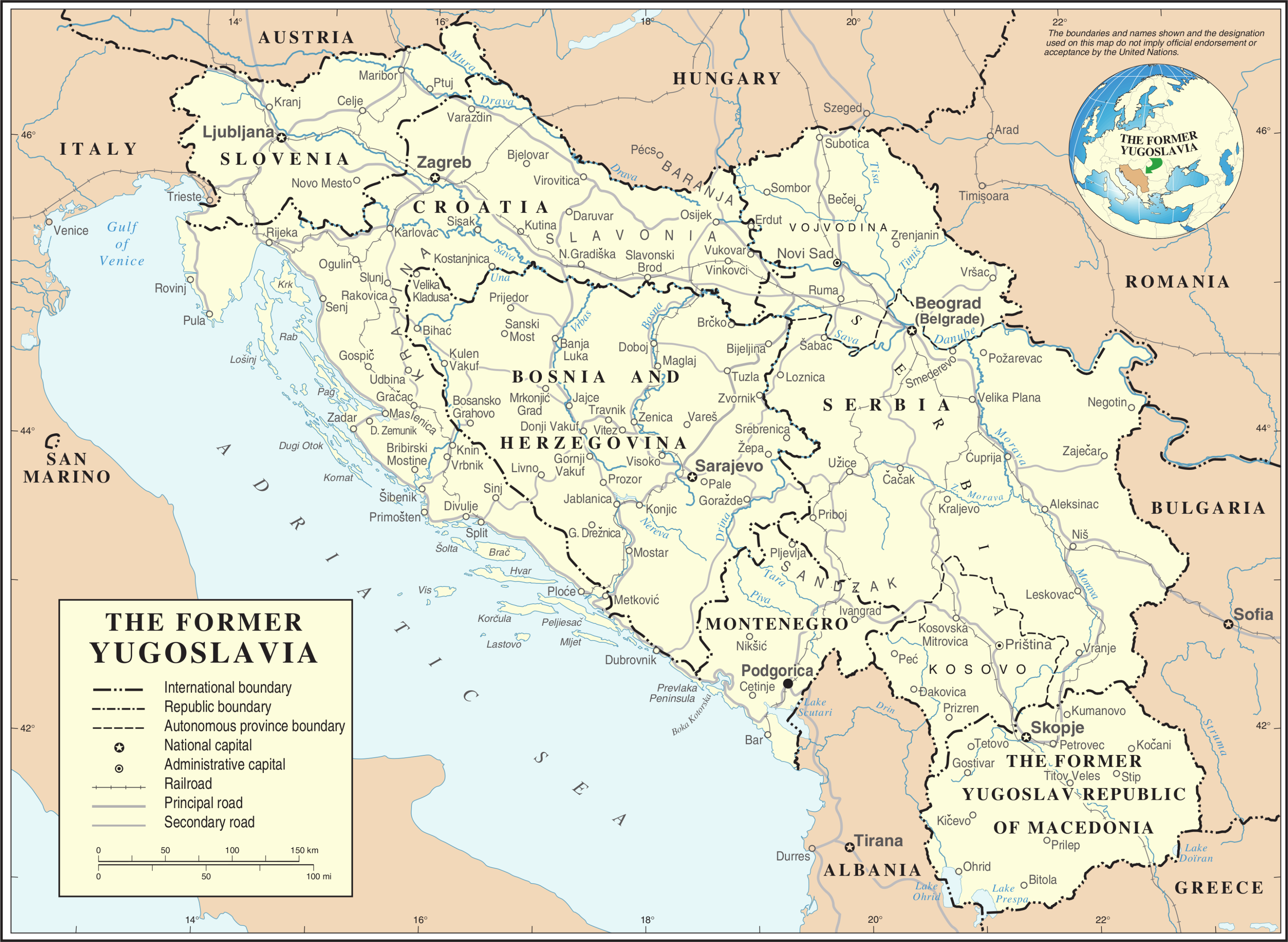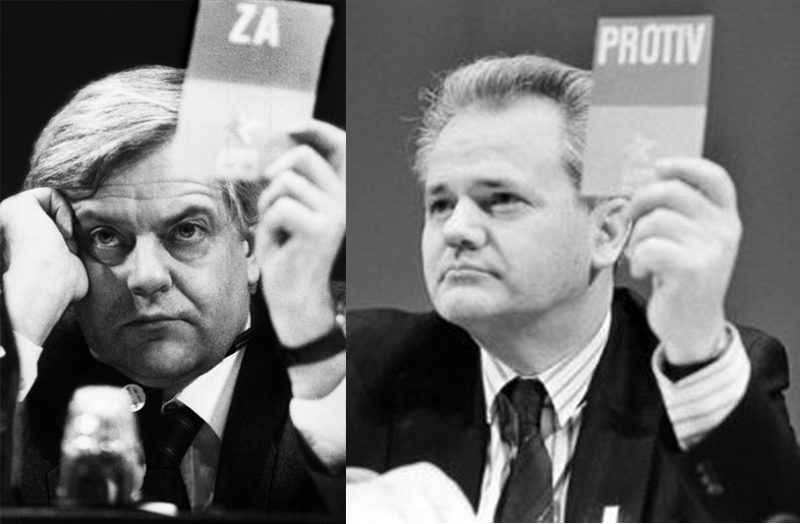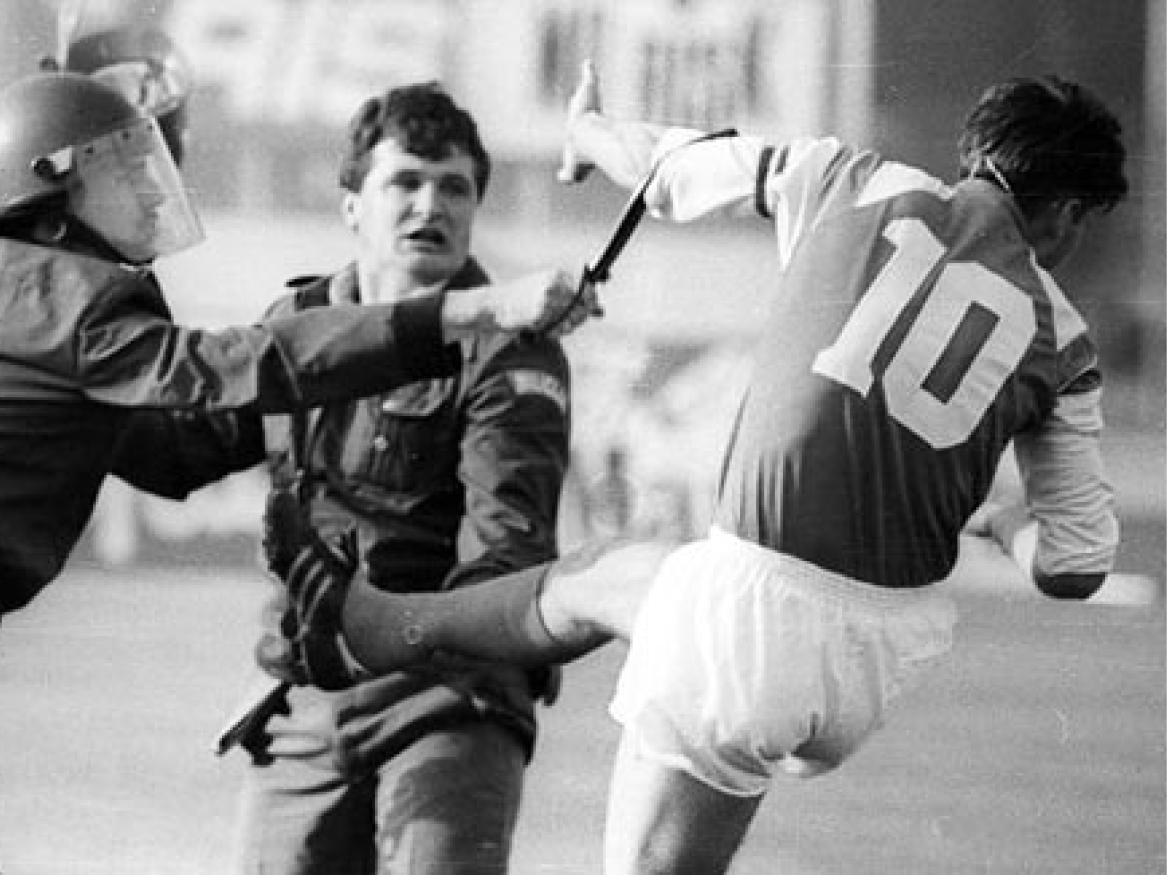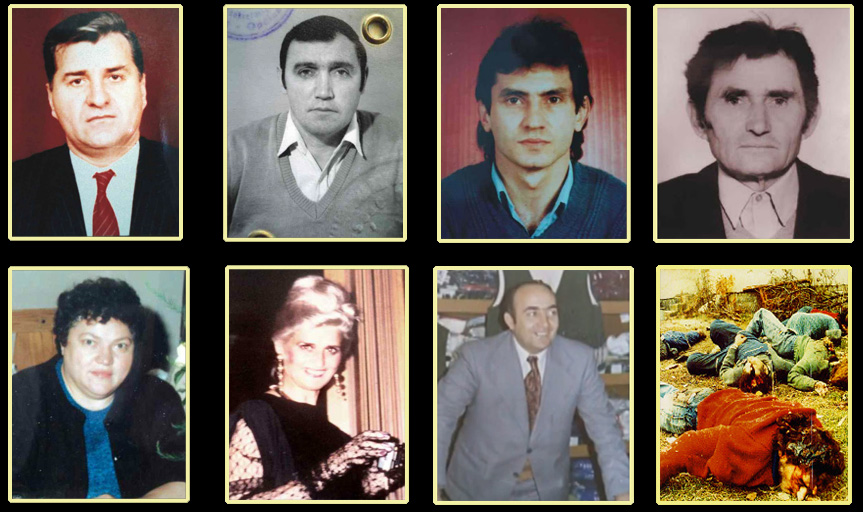Period:
Yugoslav Wars
Region:
Estern Slavonia
The Serb victim Stevan Inić - Vukovar 1991
Stevan Inić (1928–1991) was the first (serbian) victim in the municipality of Vukovar in 1991. He was shot and killed by his neighbor, Mihajlo "Mijo" Gelenčir, on May 1st, 1991, in the village of Bršadin.
The murder was committed out of chauvinistic hatred, as Stevan Inić had been carrying a Yugoslav flag on his way to the nearby Đergaj forest to celebrate the May Day holiday, where many of his friends and neighbors had already gathered.

This act provoked considerable fear and tension between Serbs and Croats in eastern Croatia. The situation escalated sharply, contributing to the outbreak of violence in the nearby village of Borovo Selo shortly thereafter.
This murder was one of the preludes to the outbreak of armed conflict in Vukovar later in 1991. It is particularly significant to note that Stevan Inić was killed three months before the full-scale war began in Vukovar.
BACKGROUND
SFR Yugoslavia was a federal state made up of 6 republics (FR Slovenia, FR Croatia, SR Bosnia, and Herzegovina, SR Montenegro, SR Serbia, and SR Macedonia). Both Yugoslavia and the JNA were established on the principle of “brotherhood and unity” of all peoples and nationalities who lived in the SFRY.
The social and economic system of the SFRY was socialism.
The 1974 Constitution of Yugoslavia brought about the decentralization of the SFRY, which later enabled the separatist forces in Slovenia and Croatia, and later in Bosnia and Herzegovina to begin the dissolution of Yugoslavia, followed by bloody wars and persecution.

In all the constitutions of Yugoslavia, the Yugoslav People's Army was defined as the only legitimate armed force in the territory of the SFRY, and therefore, the only internationally recognized military entity. At the end of 1989, the SFRY Assembly passed amendments to the Constitution, thus replacing the one-party system with the multiparty system, which meant that besides the Alliance of Communists of Yugoslavia, other parties could now be formed.
At the end of January 1990, the Alliance of Communists of Yugoslavia collapsed, at the 14th SKY Congress in Belgrade, when sharp verbal clashes between Slovenian and Serbian delegates occurred regarding the future of the joint state of the SFRY.

Opposing sides - Kučan and Milosević
The Slovenian delegation left the session, immediately followed by the delegation of the FR Croatia, which brought the issue of the congress into question. After them, the delegations of the FR of Bosnia and Herzegovina and the FR of Macedonia also left the congress.
Thus, after 45 years, the rule of the communists in SFRY ended.
The situation in FR Croatia
On the multi-party elections held in FR Croatia on 22 April 1990, the HDZ party won with its political program clearly stating the desire for independence and separation of FR Croatia from SFRY.

Collaborators against the Serbs: Tudjman and Račan
The victory sparked great euphoria throughout the Federal Republic of Croatia and displays of images of Ustasha criminals (Ante Pavelić, Alojzije Stepinac, Vjekoslav Luburić, and others), while Ustasha greetings and Ustasha songs could be frequently heard. This brought back memories of Serbs in SR Croatia of persecution and genocide in the Independent State of Croatia (The Nazi project between 1941-1945).
As early as spring, the HDZ and Franjo Tudjman took control of the police, the media, the prosecution and the state administration. Serbs working in the police were forced to leave in the spring of 1990 immediately after taking over the power, when the conflict at Maksimir (Zagreb's football stadium) between fans of NK Dinamo (Croatia) and FC Red Star (Serbia), were misused for anti-Serb propaganda.
Thus began a media war against everything that had to do with Serbia and Yugoslavia. In summer, the authorities of the FR Croatia in Zagreb made the decision to form the armed forces themselves. In October and November 1990, a large amount of weapons were illegally imported into the Federal Republic of Croatia for the needs of the reserve police forces, members of the HDZ and the VOC. The action was led by Martin Špegelj and Josip Boljkovac, ministers in the then government of Croatia.
Illegal arming of Croats
The JNA Counterintelligence Service made a film about this endeavor at the JNA military training polygon in Gakov in October 1990 and released it on TV Belgrade on 27 January 1991. On 22 December 1990, a "Christmas Constitution" was solemnly proclaimed in the Parliament, by which the Serbs lost their decades-old constitution rights and Croatia removed the name "socialist" in its name.
Since May 1990, the situation in FR Croatia started worsening day by day and the Serbs were terribly scared for their personal security and their property. Ustasha graffiti, slogans, posters could be seen regularly, and a large number of Serbs received threats by phone that they had to move out of their homes and go to SR Serbia. They even received threatening letters bearing the "HDZ" signature.

Violence in Zagreb at the Maksimir stadium
Even Croats who were married to Serbs received such threats.
Serbs in Croatia were fired from their jobs, and even their children were mentally and physically abused in schools. In almost all settlements where Croats had an absolute or relative majority, there were certain members of the HDZ party who had a task to keep an eye on the movement of their Serb neighbors (espionage).
Situation in Bršadin
Bršadin is a village located between Vukovar and Vinkovci, situated on the border of Western Srem and Eastern Slavonia. For centuries, it has been inhabited predominantly by Serbian Orthodox residents, although it was originally founded by Hungarian peasants. However, the settlement was depopulated during the Ottoman conquests in the late 15th century.

Central area in Bršadin
The Vuka River flows past Bršadin toward the Danube. The area surrounding the village includes fertile agricultural land and the Đergaj forest.
During the First World War, a large military hospital was constructed here to serve the needs of the Austro-Hungarian army. Additional buildings were erected as well, forming a small town made entirely of wood, hence its nickname, "Wooden Vienna" (Drveni Beč). However, the settlement was destroyed in a fire in late November 1918.
In the Second World War, Bršadin became part of the Partisan resistance movement. It was the birthplace of national hero Vaso Đurđević, who was killed in May 1944 in combat against Croatian fascists (Ustaše). After the WW2, the village underwent nationalization and agrarian reform.

In the 1950s, 1960s, and 1970s, Bršadin experienced rapid growth due to the settlement of people from impoverished regions of Bosnia, Banija, Kordun, and Herzegovina.
The village fostered local traditions, particularly folklore and football. The church and village festival (kirbaj) was celebrated on July 26th, the feast day of Saint Archangel Gabriel.
BIOGRAPHY
The late Stevan Inić was born in 1928 in the Dalmatian village of Zapužane near Benkovac. At the age of sixteen, in 1943, he joined the Partisan resistance movement during World War II. After the war, he was sent to Belgrade for officer training.
However, disliking military life, he left the military academy and instead joined a youth labor brigade in southern Serbia, helping to build the Mavrovo hydroelectric power plant. There, he was awarded the title of “triple shock worker” for his efforts.

In 1948, he moved to the village of Ivankovo near Vinkovci, where he married a woman of Croatian ethnicity. He initially worked in an agricultural cooperative and later joined the Yugoslav Railways as a conductor. Widely liked, he was known for his compassion,being from a poor background himself, he would not evict impoverished passengers from trains during those difficult postwar years. He retired in 1985.
In 1959, he purchased a plot of land in Bršadin, a Serb-majority village closer to Vukovar than Vinkovci. There he built a house and raised his children, whom he taught to be honest and hardworking.
Until 1986, Stevan Inić served as the president of the local chapter of the SUBNOR (Association of Veterans of the National Liberation War) in Bršadin.
THE MURDER
On May 1st, 1991, as he had done every year, Stevan Inić set out to carry the flag of the Socialist Federal Republic of Yugoslavia, with the red star, to the nearby Đergaj forest, where locals traditionally gathered to celebrate the state holiday.
They would roast a pig on a spit, socialize, sing, and dance.
Upon seeing Inić carrying the flag, his neighbor, Mihajlo "Mijo" Gelenčir of Bršadin—a member of the militant, pro-Ustasha Croatian Democratic Union (HDZ) led by Franjo Tuđman—was enraged. He insulted Inić, calling him a “Serb motherf***er” and a “Chetnik,” and said of the flag:
“You won’t be carrying or waving that anymore.”
According to official autopsy findings, Inić was killed by a shot from a pistol fired at close range (1–2 meters) while he was lying on the ground.
However, Croatian media portrayed the event with a sensationalist, "cowboy" narrative, claiming that the two had argued and then fought, that Gelenčir hit Inić with a scythe, and that after Inić fell, Gelenčir took Inić's alleged pistol and shot him.
Yet those who knew Stevan Inić find this story implausible. He was an elderly man, 164 cm tall, weighing 65 kg, and aged 63 at the time. Clearly, he was not the “Rambo-like” figure described in certain Croatian outlets.
The first person to arrive at the crime scene was their neighbor, Nevenka Miljević. Though she did not witness the entire incident, she heard the quarrel and then a gunshot. As she approached, she saw Gelenčir leaving with a wheelbarrow, a scythe, and a pitchfork, while Inić, mortally wounded, was still trembling. She stated that she saw a pistol, but it remains unclear how the weapon vanished just minutes later, when a crowd of neighbors began to gather.
CONSEQUENCES
Police officers from the Vukovar Public Security Department (SUP) were unable to immediately investigate the crime scene, as residents of Bršadin, fearing further attacks by Croats on their village, had blocked the roads with logs and tree trunks. For this reason, the investigation was carried out by officers from the Osijek Public Security Department. Even a team from Zagreb Television (TV Zagreb) arrived to report on the crime.
Allegedly, a criminal trial was held in Osijek against Mihajlo "Mijo" Gelenčir for the killing, but the outcome of the trial remains unknown.
On the following day, May 2, 1991, Croatian special police forces launched an incursion into the village of Borovo Selo, but the local population, led by Vukašin Šoškoćanin, managed to repel the attack.
YEARS LATER
Following the reintegration of the Eastern Slavonia, Baranja, and Western Srem region into the Republic of Croatia in 1997, Mijo Gelenčir reportedly returned to Bršadin (by then allegedly blind).
He had two daughters who were married in the village, and also a son. In 2006, that son brought his own son in front of the house that once belonged to the late Stevan Inić and said:
"Look, son, your grandfather Mijo killed a Chetnik from this house!"
Overhearing the accusation, Stevan Inić (b. 1950) could not remain silent. He told Gelenčir’s son to leave, saying that his father, Stevan Inić, was not a Chetnik but a Partisan and a veteran of the People's Liberation War (NOR).
Gelenčir’s son got into his SUV and left. The family of the murdered Stevan Inić never initiated legal proceedings against Mihajlo Gelenčir. Today, none of the individuals involved are still alive.
CONTROVERSIES
According to some Croatian sources, a different version of events exists regarding the murder of Stevan Inić, the retired railway worker from Bršadin. In their narrative, Mihajlo Gelenčir acted in self-defense, supposedly after being provoked by Inić over a period of time.
They claim that Stevan threatened to kill Gelenčir and went home to get a pistol, whereupon Gelenčir—allegedly mowing grass at the time—struck him with a scythe, causing the pistol to fall to the ground, which Gelenčir then picked up and used to shoot Inić.

Some of Serbian civilian victims in Vukovar, 1991
What makes the case even more tragic is the fact that the pistol used to kill Stevan Inić reportedly disappeared only minutes after the murder. Moreover, Gelenčir was taken the same day toward the Croatian village of Tovarnik.
However, this version of events contains numerous inconsistencies, especially when considering the political climate in Vukovar during the spring of 1991 and the actions taken at the time by Tomislav Merčep and his associates in the region.
PUBLICATIONS
To date, no documentary film has been produced about the murder of Stevan Inić, nor has any book or serious academic study been written on the subject. Likewise, no public forum, scholarly conference, or similar event has been held in the former Yugoslav region to address his killing.
His name appears on a few websites, primarily in reference to the outbreak of civil war in the Republic of Croatia in the early 1990s.
|
WAR AND CRIMES IN VUKOVAR 1991
|
| CRIMES |
Killing of civilians * Karadzicevo * Kriva Bara
Nikolas Demonje Street * Kozaracka Road
Battle of Borovo Selo * Vukovar * Discrimination
|
| CRIMINALS |
Marko Babic * Mile Dedakovic * Zoran Šipoš
Martin Sabljic * Nikola Cibaric * Jure Marusic
Mira Dunatov * Ante Vranjkovic * Ivica Mazar
Vinko Leko * Vlado Lulic * Damir Sardjen * Dosen
Stipo Pole * Mante Mandic * Dujmovic * Raguz
Drazen Gazo * Tomislav Josic * Turbo vod
Blago Zadro * Tihomir Purda * Bartol Domazet
Madjarevic * Tomislav Mercep * Darko Mihaljevic
Zdenko Stefancic * Filkovic * Kolak * Prgomet
204th brigade * Gnezdo * Colak * Ivica Arbanas
Sandor * Franjo Vodopija * Branko Borkovic
Plavsic * Petar Kacic * Juraj Njavro * Hosovci
Damjn Samardzic * Josip Tomasic * Velimir Djerek
Ivan Poljak * Andjelic * Jurkic * Kole Kovacic
Miroslav Sucic * Zdravko Radic * Brothers Molnar
|
| CAMPS |
Drvopromet * Nova Obucara *Borovo komerc * Luzac
Ruthenian Church * Aerodrom * Jews cementary
Police Department * Pizzeria Abazia * Eltz castle
New school * Recruitment office
Kindergarten Pcelica * Municipal basement |
| VICTIMS |
Jovan Jakovljevic * Radovan Stojsic * Ana Lukic
Mladen Mrkic * Vlado Skeledzija * Miroslav Radic
Stevan Inic * Darinka Grujic * Ljuban Vucinic
Zeljko Pajic * Milica Vracaric * Mirko Pojatic
Milenko Djuricic * Zoran Filipovic * Bosko Grbic
Ilija Lozancic * Stevo Malecki * Branko Mirjanic
Predrag Ciric * Sucevic * Ljubomir Bolic
Slavko Miodrag * Milan Vezmar * Marko Tolic
Sveto Nedeljkovic * Nedeljko Zunic
|
|
PUBLICAT.
|
Vuteks brand * Ovcara VS Dudik * Zvonko Ostojic
Milanovic and Plenkovic * Bloodsuckers of Sajmiste
Unspoken things * Autochauvinism * Terms confusion
Not admitting the crime * Vukovar through the centuries
Transcripts * Slavonian Napoleon
One-sided past * Hypocrisy in judgments
|
CONCLUSION
During the 1990s, Croatia’s propaganda apparatus skillfully concealed such cases, promoting half-truths in order to justify the killing of an innocent, unarmed man. Civilian killings like that of Stevan Inić served as a trigger for the escalation of armed conflict in the territory of AVNOJ-era Croatia. Leading figures in the Croatian Democratic Union (HDZ) were fully aware that only war could facilitate the expulsion of hundreds of thousands of Serbs, reducing their presence to a "tolerable" three percent.
By 1995, the Tuđman regime had gained international support to continue its genocidal campaign. Ultimately, it succeeded in realizing a plan originally conceived during World War II by Ante Pavelić and the Roman Catholic Church.
Given that Serbs have been portrayed throughout the Western world as the primary culprits of the Yugoslav wars, it is difficult to believe that the truth about the murders of innocent Serbian civilians in the spring and summer of 1991 in the Vukovar municipality will ever come to light, or that the perpetrators will be held accountable.
Acknowledging such truths would alter the narrative and background of the war itself and dismantle the myth of the so-called "Greater Serbian aggression."
Tags:
Please, vote for this article:
Visited: 610 point
Number of votes: 0
|